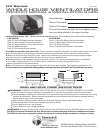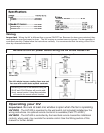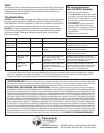
Figure 1.
Figure 2.
Figure 3.
Figure 4.
Figure 5.
Installation
T
ools and supplies needed (Not Included):
You will need the following items: two pieces of 2x stock to match your existing
framing, a saw to cut the hole in the ceiling, a hammer or screw gun to attach
the blocking to the existing joists, a phillips head screw driver to attach the grille,
weather strip material and low expansion spray foam sealant. For the HV1000,
a single pole, single throw (SPST)wall switch will be needed.
1. The fan housing will fit either 16” or 24” on center framing. Cut
t
wo pieces of 2x stock (2 x 6 or 2 x 8 etc.) of the same dimension as
the existing joists. Add these pieces of framing to form a box between
the joists. (Figure 1).
TIP: When the HV is to be installed in a hallway or other location with low
ceilings, some homeowners find that building a box out of 2 x 10s or similar
material will raise the HV to a position where the sound level will be reduced
but the efficiency of the fans will not be diminished. This box should not
exceed 12 inches in height.
2. Cut a hole in the ceiling under where the HV will be installed. The
hole should be no larger than 14 1/2" x 22 1/2". This will allow for the
grille to cover the exposed edges. The suggested method for making
the proper sized hole in the ceiling is; cut a pilot hole under where
the fan will be installed. (Figure 2) From above, using a saw, cut
along the inside edge of the framework removing the ceiling panel
and any strapping within the frame. Do not damage electri-
cal wiring or other hidden utilities.
3. Install a foam weather stripping or other flexible material (not sup-
plied) on the top of the joists and added framing. This will serve to
seal between the housing and the framing as well as dampen vibra-
tions. Check the joint between the ceiling and the 2x stock. Some
types of ceilings are spaced away from the joists. Any gap between
the 2x’s and the ceiling should be sealed prior to final installation.
(Figure 3) Use a low expansion spray foam sealant (not supplied).
4. Set the HV on the gasket with the doors facing to open into the
attic. The lower housing will fit into the box with the mounting flanges
overlapping the joists. (Figure 4) The HV should not be
forced into this opening. Forcing it into place may cause the
doors to bind and not function properly.
5. If desired, secure the HV to the top of the joists using the #8x3/4
screws provided. When fastening the mounting flange to the joists
care should be taken that all screws are tightened evenly to avoid
the door hinges binding.
6. Wire the HV as shown in the Wiring section of this manual.
It is recommended that the wiring of the HV be done by a
licensed electrician.
7. Check the HV for proper operation. Turn the unit on and
allow 30 seconds for the doors to fully cycle open and the fans to
start.
DO NOT FORCE THE DOORS OPEN.
8. Install the grille (6 screws included) on the ceiling below the fan
(Figure 5).
TIP: Some owners find the installation has a more finished
look when the inside of the blocking has been painted before
the unit is installed and the grille is put in place.






